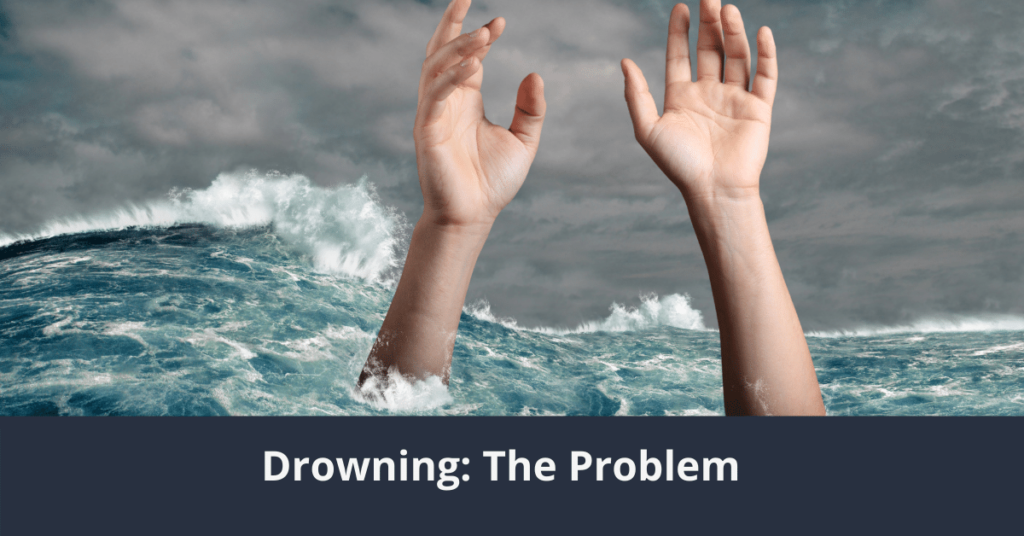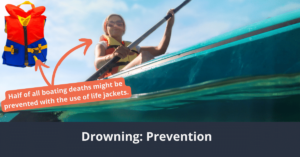Did you know drowning is one of the leading causes of death worldwide? Surprisingly, drownings are the leading cause of death in children aged 1-4 1,2 and account for over 9% of the global mortality rate, the third-highest in unintentional injury deaths 21 .
Despite drowning being a known risk, many lack the awareness of just how dangerous and widespread it is. In Part 1. “The Problem” of our three-part series will be focusing on statistics that show just how prevalent this devastating event is and the segments of our population that are most affected.
Everything you will learn here
How Big Is the Problem and Who’s Most Impacted?
The purpose of this three-part series is to empower you to keep yourself and your family safe. Please find Part 2. Risk Factors, which focuses on how and where people drown and Part 3. Prevention, which focuses on the latest research in drowning prevention, arming with you the knowledge to keep you and your family safe!
United States Drowning deaths
Drowning is the second leading cause of unintentional injury death in children aged 1–14 years. 21
1 drowning death every Hour 23
11 drowning deaths per Day 23
333 drowning deaths per Month 23
4,000 drowning deaths per Year 23
- In the United States of America, 45% of drowning deaths are among the most economically active segment of the population. 21
- Drowning is the second leading cause of unintentional injury death in children aged 1–14 years.21
Worldwide Drowning Deaths
In 2015, drownings accounted for over 9% of total global mortality. Drowning is the 3rd leading cause of unintentional injury death, accounting for 7% of all injury-related deaths.21
42 drowning deaths every Hour 21
1,019 drowning deaths per Day 21
31,000 drowning deaths per Month 21
372,000 drowning deaths per Year 21
- In 2016, an estimated 372 000 people died from drowning, making drowning a major public health problem worldwide. 21
- In 2015, drownings accounted for over 9% of total global mortality. Drowning is the 3rd leading cause of unintentional injury death, accounting for 7% of all injury-related deaths.21
- Drowning is responsible for more deaths among children 1-4 than any other cause except congenital anomalies (birth defects).1,2
- Among those 1-14, fatal drowning remains the second-leading cause of unintentional injury-related death behind motor vehicle crashes.1
- Drowning is one of the top 5 causes of death for people aged 1–14 years for 48 of 85 countries with data meeting inclusion criteria in the World Health Organization Global Report on Drowning.21
– Who’s Most At Risk? –
Children
- Children ages 1 to 4 have the highest drowning rates. In 2014, among children 1 to 4 years old who died from an unintentional injury, one-third died from drowning. 1,2
- Among children ages 1 to 4, most drownings occur in home swimming pools.2
- Drowning is responsible for more deaths among children 1-4 than any other cause except congenital anomalies (birth defects).1,2
- Among those 1-14, fatal drowning remains the second-leading cause of unintentional injury-related death behind motor vehicle crashes.1
- United States of America: drowning is the second leading cause of unintentional injury death in children aged 1–14 years.21
- Drowning is one of the top 5 causes of death for people aged 1–14 years for 48 of 85 countries (worldwide) with data meeting inclusion criteria in the World Health Organizations Global Report on Drowning. 21
Minorities
- Between 1999-2010, the fatal unintentional drowning rate for African Americans was significantly higher than that of whites across all ages 5 while the disparity was widest among children 5-18 years old.
- African American children 5-19 drown in swimming pools at rates 5.5 times higher than those of whites. 5 This disparity is greatest among those 11-12 years where African Americans drown in swimming pools at rates 10 times those of whites.
- Factors such as access to swimming pools, the desire or lack of desire to learn how to swim, and choosing water-related recreational activities may contribute to the racial differences in drowning rates. Available rates are based on population, not on participation. If rates could be determined by actual participation in water-related activities, the disparity in minorities’ drowning rates compared to whites would be much greater.6
Males
- Nearly 80% of people who die from drowning are male.2
- Males are especially at risk of drowning, with twice the overall mortality rate of females. They are more likely to be hospitalized than females for non-fatal drowning. Studies suggest that the higher drowning rates among males are due to increased exposure to water and riskier behavior such as swimming alone, drinking alcohol before swimming alone and boating.21
Next: Understanding How and Where Drownings Occur
There’s no debating just how shockingly high these numbers are. As shown in multiple data points, drowning is one of the most likely causes of death, no matter where you reside worldwide. Drowning is a massive risk to both the first and the third-world. Special care and precaution should be taken for those who fall in additionally impacted segments, like Children, Minorities and Males.
Next, in Part 2. Risk Factors, we focus on both How and Where drownings occur. We aim to illustrate the events, activities and situations statistically shown to be most associated with drowning events and ultimately prepare you to keep yourself and your family safe!
Continue with Part 2. Risk Factors
Continue with Part 3. Prevention
Sources
- Centers for Disease Control and Prevention, National Center for Injury Prevention and Control. Web-based Injury Statistics Query and Reporting System (WISQARS) [online]. [cited 2012 May 3]. Available from: URL: http://www.cdc.gov/injury/wisqars.
- CDC. Wide-ranging online data for epidemiologic research (WONDER). Atlanta, GA: CDC, National Center for Health Statistics; 2016. Available at http://wonder.cdc.gov.
- Cummings P, Quan L. Trends in Unintentional Drowning: The Role of Alcohol and Medical Care. JAMA, 1999; 281(23):2198-2202.
- Spack L, Gedeit R, Splaingard M, Havens PL. Failure of aggressive therapy to alter outcomes in pediatric near-drowning. Pediatric Emergency Care 1997; 13(2):98-102.
- Gilchrist J, Parker EM. Racial/ethnic disparities in fatal unintentional drowning among persons aged ≤29 years—United States, 1999–2010. MMWR 2014;63:421–6.
- Branche CM, Dellinger AM, Sleet DA, Gilchrist J, Olson SJ. Unintentional injuries: the burden, risks and preventive strategies to address diversity. In: Livingston IL, editor. Praeger handbook of Black American health (2nd edition): Policies and issues behind disparities in health. Westport (CT): Praeger Publishers; 2004. p. 317-27.
- Gilchrist J, Sacks JJ, Branche CM. Self-reported swimming ability in U.S. adults, 1994. Public Health Reports 2000;115(2–3):110–1.
- Irwin CC, Irwin RL, Ryan TD. Urban minority youth swimming (in)ability in the United States and associated demographic characteristics: toward a drowning prevention plan. Injury Prevention 2009; 15: 234-239.
- Brenner RA, Taneja GS, Haynie DL, Trumble AC, Qian C, Klinger RM, Klevanoff MA. Association between swimming lessons and drowning in childhood: A case-control study. Archives of Pediatrics & Adolescent Medicine 2009;163(3):203-10.
- Yang L, Nong QQ, Li CL, Feng QM, Lo SK. Risk factors for childhood drowning in rural regions of a developing country : a case-control study. Injury Prevention, 2007; 13:178-182.
- U. S. Consumer Product Safety Commission. Safety barrier guidelines for home pools [online]. [cited 2012 May 3]. Available from URL: http://www.cpsc.gov/cpscpub/pubs/pool.pdf
- Thompson DC, Rivara FP. Pool fencing for preventing drowning in children. Cochrane Database of Systematic Reviews 2000; 2.
- U. S. Consumer Product Safety Commission. Submersions related to non-pool and non-spa products, 2011 report.[online]. [cited 2012 May 9]. Available from URL: http://www.cpsc.gov/LIBRARY/FOIA/FOIA11/os/nonpoolsub2011.pdf
- Pelletier AR, Gilchrist J. Fatalities in swimming pools with lifeguards: USA, 2000-2008. Injury Prevention, 2011;17:250-253.
- U.S. Coast Guard, Department of Homeland Security (US). Recreational Boating Statistics – 2010 [online]. [cited 2012 May 3]. Available from: http://www.uscgboating.org/assets/1/workflow_staging/Page/2010_Recreational_Boating_Statistics.pdf
- Cummings P, Mueller BA, Quan L. Association between wearing a personal floatation device and death by drowning among recreational boaters: a matched cohort analysis of United States Coast Guard data. Injury Prevention 2011;17:156-159.14.
- Driscoll TR, Harrison JA, Steenkamp M. Review of the role of alcohol in drowning associated with recreational aquatic activity. Injury Prevention 2004;10:107–113.
- Lhatoo SD, Sander JWAS. Cause-specific mortality in epilepsy. Epilepsia 2005; 46(Suppl. 11):36–39.
- Kyriacou DN, Arcinue EL, Peek C, Kraus JF. Effect of Immediate Resuscitation on Children with Submersion Injury. Pediatrics, 1994; 94 (2): 137-142.
- World Health Organization, Global Report on Drowning, available at URL:
https://www.who.int/publications/i/item/global-report-on-drowning-preventing-a-leading-killer



